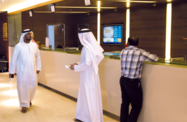The conservative approaches to money management employed by for four Sharjah-based lenders have paid off judging by their year-end financial statements for 2010, which have recently been released.
In its performance report for the year, Sharjah Islamic Bank posted a net profit of $72.5m, an increase of 2.4% over 2009. The bank’s total assets also reached $4.55bn, a 4.3% increase year-on-year (y-o-y), while earnings per share (EPS) stood at $.03 at year-end.
Meanwhile, the Bank of Sharjah (BoS) also registered solid results, with assets climbing to $5.6bn, a 14% increase over the previous year. However, despite increasing asset holdings, raising its liquidity levels and bolstering equity, the bank saw a 15% decline in profits y-o-y, from $129.3m to $110m. BoS attributed this to the need to maintain high levels of liquidity in money market instruments at historically low interbank interest rates. The bank’s EPS was thus reduced to $.05, down from the previous year.
Speaking to the local press, Varouk Nerguizian, the executive director and general manager of BoS, said, “2010 was a very challenging year for the banking industry.” Despite this, he went on to add that, “The balance sheet of BoS witnessed solid growth in its structure.”
Meanwhile, another Sharjah-based lender that reported growth was Investbank, which mainly focuses on the corporate sector. Investbank posted net profits of $81.9m for the year, while the bank’s EPS was $0.07 and total assets reached $2.8bn, up 7% over 2009
The United Arab Bank (UAB) also recorded solid gains for 2010, posting profits of $83.8bn, a 10% increase y-o-y from $76.5m. UAB’s total assets climbed to $2.1bn and EPS was $.08 for the year.
As the raft of positive earnings reports reveal, local banks have benefitted from the economic recovery taking hold across the UAE, with the country’s nominal GDP reaching some Dh928bn ($252.62bn), up 1.5% y-o-y, in 2010. Oil prices are currently high due to ongoing supply concerns – benchmark Brent crude was trading just under $110 a barrel in mid-March. As the third-largest exporter in OPEC, the economic outlook for the UAE looks set to be broadly positive, with rising oil revenues likely to drive growth across the country.
Following consultations with the UAE government on March 7, the IMF released a statement saying that it expected the country’s GDP growth to reach 3.25% in 2011, although it also noted that there are risks going forward. “Risks to the recovery remain, including from possible economic spill-overs of regional events. For example, the current re-pricing of political and sovereign risks in the region could lead to more challenging market conditions,” said the IMF’s mission head, Taline Koranchelian.
That said, local banks are well placed to profit from the country’s growth. A common theme in reports on the emirate’s banks is their stability, with assessments from credit ratings agencies stressing the low level of non-performing loans held by most conventional banks, as well as the sound asset holdings of both conventional and Islamic lenders. Having avoided the boom-and-bust cycle that affected some regional competitors over the past 18 months, Sharjah’s lenders are now well positioned to benefit from the ongoing recovery.
Sharjah’s banks are expected to continue focusing on their strengths, characterised by a relatively conservative approach, which has enabled them to build a sound base for expansion. With economic growth likely to continue apace in the year ahead, this base seems likely to serve them well.

